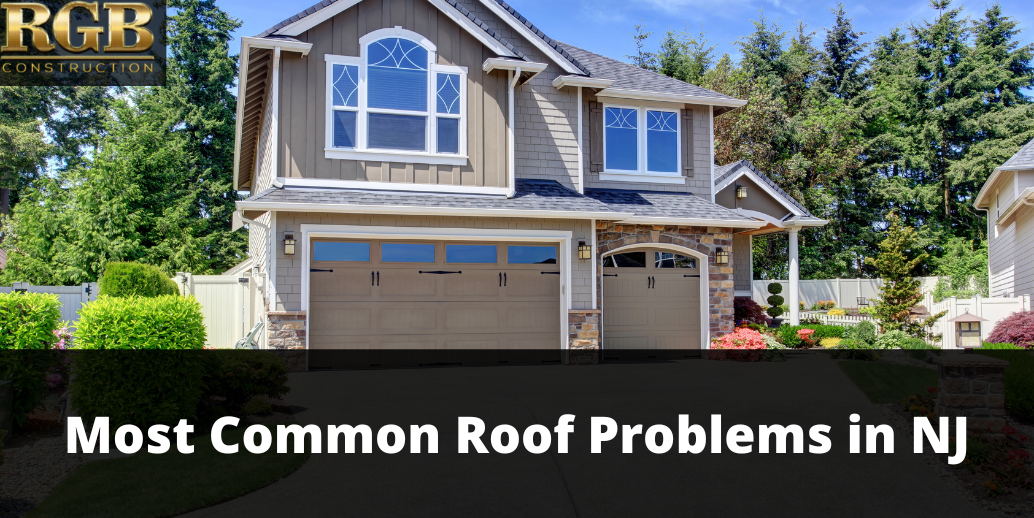Your roof is one of the most important parts of your home’s exterior. It not only keeps rain, wind, snow, and sleet out of your home, but it is also a critical part of the energy efficiency system. Your roof helps keep your house cool in the summer and warm in the winter while also reducing how hard your HVAC system works. When your roof is not working properly, your HVAC system works harder and could lead to a reduction in its life expectancy. For this reason, RGB Construction wants you to know the most common roof problems in New Jersey so you can recognize them quickly in order to prevent additional issues in your home.
Damaged or Missing Shingles
Damaged or missing shingles are one of the most common issues faced by roofers in NJ. Shingles can be damaged by wind or rain in a storm, falling tree limbs, or other debris or sun exposure. They can also simply fail due to age. Too often, a broken or missing shingle is overlooked which may lead to additional damage to the roof. The longer they go without being replaced, the more likely problems will develop in other areas of your roof.
Leaks in the Roof
Another common problem homeowners face is a leaky roof. There are many reasons why your roof may be leaking and, if these leaks are ignored, you could suffer additional damage that may be expensive to repair. Keep in mind that a leak may be small so there are things to look for, according to NJ roofing contractor technicians. Look around your chimney, near the flashing, and around gutters or skylights. You may also notice leaks in valleys or close to vents. Some common reasons why your roof may develop a leak include broken shingles or cracked flashing. If you have a tile or slate roof, the leaks may be caused by broken or cracked tiles.
Clogged Gutters
No one enjoys clearing debris from their gutters but failing to do so can lead to roofing problems. The longer debris remains in your gutters, the more likely it is that water will back up into your roofing system. In the winter, the issue can grow especially concerning as the water trapped in the gutter can freeze, creating ice dams that will push up under your roof, allowing additional water to seep inside. Roofers in NJ suggest cleaning your gutters several times each year, especially prior to any expected rainfall. If you are no longer able to clean your gutters or would prefer not to climb a ladder to do so, consider installing gutter screens that will reduce how much debris collects inside.
Storm Damage
New Jersey deals with a significant amount of severe weather. Along the coastline, hurricanes, nor’easters, and tropical storms can cause significant damage to roofs. Throughout the state, ice and snowstorms in the winter can lead to damage. In addition, New Jersey ranks in the top ten states for hail damage claims. After a storm, it is highly recommended that you have a qualified NJ roofing contractor inspect your roof for any damage so that it can be repaired quickly.
Standing or Pooling of Water
If you have a slanted roof and notice standing or pooling water, it is possible you have damage to the underlayment of your roof that is causing it to sag. However, this issue is more common on flat roofing systems. Your flat roof should have a good drainage system that prevents water from standing or pooling. If it is not working properly, the standing water can cause too much moisture to build up leading to mold, mildew, or algae formation. Water can also seep through your roof into your support system causing significant damage.
Flashing Damage
Flashing protects the protruding areas of your roof from water damage. It is usually installed around vents, chimneys, skylights, or any HVAC systems installed on the roof. Your flashing should be attached securely and correctly, or you will develop problems quickly. If the flashing is not installed properly or suffers damage, water can seep underneath the flashing and not only damage the roof, but the system it is designed to protect, like your chimney or vent system.
Roof Shrinkage
A common issue that impacts synthetic rubber membrane roofing is shrinkage, although it can occur on any type of roofing material, RGB Construction explains. Keep in mind that materials on your roof are shrinking and expanding constantly which can lead to pulling in all directions. The weather has an impact on how much your roofing materials expand or contract so areas with extreme weather may see this type of damage more often. Signs of shrinkage include tears around the flashing or on the shingles. In most cases, proper installation will prevent shrinkage from being a problem, but all synthetic rubber membrane roofing systems should be inspected periodically.
Pest Infestations
Unwanted pests are another way that your roof can be damaged. Although you may be aware of pests like termites and carpenter bees which can damage the structure of your home as well as your roof, other pests may be less apparent. Birds may nest inside your chimney and, when it is time to use a fireplace or furnace, the next could keep dangerous fumes from escaping. Squirrels or other rodents may chew through sections of your roof or the underlayment trying to get inside where it is warm. If you suspect damage from pests, contact a qualified roofing contractor to inspect for any damage.
If you believe your roof is damaged, contact RGB Construction today to see how we can help. Our team will perform a no-obligation inspection and get your roof back in perfect working order as quickly as possible. Arrange an appointment by calling 856-264-9093 or filling out the easy online form.







